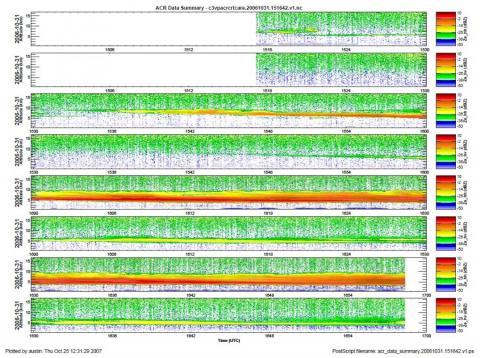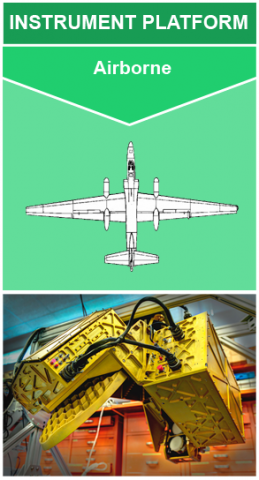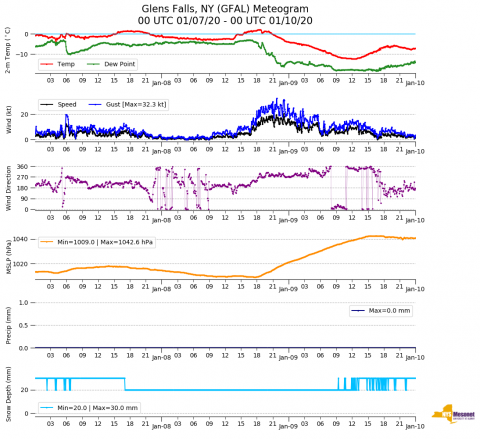 The NASA Global Hydrology Resource Center (GHRC) DAAC published the Cloud Radar System (CRS) IMPACTS dataset. This dataset consists of calibrated radar reflectivity, Doppler velocity, linear depolarization ratio, and normalized radar cross-section estimates collected by the Cloud Radar System (CRS) onboard the NASA ER-2 high-altitude research aircraft. These data were gathered during the Investigation of Microphysics and Precipitation for Atlantic Coast-Threatening Snowstorms (IMPACTS) field campaign. IMPACTS was a three-year sequence of winter season deployments conducted to study snowstorms over the U.S Atlantic Coast (2020-2022). The campaign aimed to (1) Provide observations critical to understanding the mechanisms of snowband formation, organization, and evolution; (2) Examine how the microphysical characteristics and likely growth mechanisms of snow particles vary across snowbands; and (3) Improve snowfall remote sensing interpretation and modeling to significantly advance prediction capabilities. The CRS IMPACTS dataset files are available from January 25 through February 27, 2020 in HDF-5 format. It should be noted that the ER-2 aircraft did not operate each day of the campaign, therefore CRS data are only available for aircraft flight days.
The NASA Global Hydrology Resource Center (GHRC) DAAC published the Cloud Radar System (CRS) IMPACTS dataset. This dataset consists of calibrated radar reflectivity, Doppler velocity, linear depolarization ratio, and normalized radar cross-section estimates collected by the Cloud Radar System (CRS) onboard the NASA ER-2 high-altitude research aircraft. These data were gathered during the Investigation of Microphysics and Precipitation for Atlantic Coast-Threatening Snowstorms (IMPACTS) field campaign. IMPACTS was a three-year sequence of winter season deployments conducted to study snowstorms over the U.S Atlantic Coast (2020-2022). The campaign aimed to (1) Provide observations critical to understanding the mechanisms of snowband formation, organization, and evolution; (2) Examine how the microphysical characteristics and likely growth mechanisms of snow particles vary across snowbands; and (3) Improve snowfall remote sensing interpretation and modeling to significantly advance prediction capabilities. The CRS IMPACTS dataset files are available from January 25 through February 27, 2020 in HDF-5 format. It should be noted that the ER-2 aircraft did not operate each day of the campaign, therefore CRS data are only available for aircraft flight days.
GHRC News
 The NASA Global Hydrology Resource Center (GHRC) DAAC published the GPM Ground Validation NASA W-band Airborne Cloud Radar (WACR) C3VP dataset. This dataset consists of calibrated co- and cross-polarized radar reflectivity at 94 GHz during the Canadian CloudSat/CALIPSO Validation Project (C3VP) field campaign. The campaign took place in southern Canada in support of multiple science missions, including the NASA GPM mission, in order to improve the modeling and remote sensing of winter precipitation. The WACR is used for cloud sensing and microphysics. During C3VP, the WACR was deployed as a surface-based, zenith-pointing instrument in the Cloud Radar Trailer at the Centre for Atmospheric Research Experiments (CARE) facility in Ontario, Canada. The data include radar reflectivities in zenith-pointing orientation at the CARE facility. The dataset files are available in netCDF format from October 30, 2006 through March 2, 2007. It should be noted that the WACR did not operate each day of the campaign, therefore WACR data are only available for aircraft flight days.
The NASA Global Hydrology Resource Center (GHRC) DAAC published the GPM Ground Validation NASA W-band Airborne Cloud Radar (WACR) C3VP dataset. This dataset consists of calibrated co- and cross-polarized radar reflectivity at 94 GHz during the Canadian CloudSat/CALIPSO Validation Project (C3VP) field campaign. The campaign took place in southern Canada in support of multiple science missions, including the NASA GPM mission, in order to improve the modeling and remote sensing of winter precipitation. The WACR is used for cloud sensing and microphysics. During C3VP, the WACR was deployed as a surface-based, zenith-pointing instrument in the Cloud Radar Trailer at the Centre for Atmospheric Research Experiments (CARE) facility in Ontario, Canada. The data include radar reflectivities in zenith-pointing orientation at the CARE facility. The dataset files are available in netCDF format from October 30, 2006 through March 2, 2007. It should be noted that the WACR did not operate each day of the campaign, therefore WACR data are only available for aircraft flight days.
 The NASA Global Hydrology Resource Center (GHRC) DAAC published the High Altitude Imaging Wind and Rain Airborne Profiler (HIWRAP) for the IMPACTS field campaign. HIWRAP is a Doppler radar designed to measure tropospheric winds through deriving Doppler profiles from cloud and precipitation volume backscatter. The winds are generated by combining conical scan mode measurements at two different frequency bands (Ka- and Ku-band) and two different incidence angles (30 and 40 degrees). HIWRAP utilizes solid state transmitters along with a novel pulse compression scheme resulting in a system that is considerably more compact and requires less power than typical radars used for precipitation and wind measurements. The dataset files are in HDF-5 format from January 25, 2020 through February 27, 2020.
The NASA Global Hydrology Resource Center (GHRC) DAAC published the High Altitude Imaging Wind and Rain Airborne Profiler (HIWRAP) for the IMPACTS field campaign. HIWRAP is a Doppler radar designed to measure tropospheric winds through deriving Doppler profiles from cloud and precipitation volume backscatter. The winds are generated by combining conical scan mode measurements at two different frequency bands (Ka- and Ku-band) and two different incidence angles (30 and 40 degrees). HIWRAP utilizes solid state transmitters along with a novel pulse compression scheme resulting in a system that is considerably more compact and requires less power than typical radars used for precipitation and wind measurements. The dataset files are in HDF-5 format from January 25, 2020 through February 27, 2020.  The NASA Global Hydrology Resource Center (GHRC) DAAC published the New York State Mesonet IMPACTS dataset. This dataset is a browse-only dataset and consists of temperature, wind, wind direction, mean sea level pressure, precipitation, and snow depth measurements, as well as profiler Doppler LiDAR and Microwave Radiometer (MWR) measurements from the New York State Mesonet network during the Investigation of Microphysics and Precipitation for Atlantic Coast-Threatening Snowstorms (IMPACTS) field campaign, a three-year sequence of winter season deployments conducted to study snowstorms over the U.S. Atlantic coast. IMPACTS aimed to (1) Provide observations critical to understanding the mechanisms of snowband formation, organization, and evolution; (2) Examine how the microphysical characteristics and likely growth mechanisms of snow particles vary across snowbands; and (3) Improve snowfall remote sensing interpretation and modeling to significantly advance prediction capabilities. The Mesonet network consists of ground weather stations, LiDAR profilers, and microwave radiometer (MWR) profilers. These browse files are available from January 3 through March 1, 2020 in PNG format. It should be noted that the NY Mesonet IMPACTS data are password protected and available via an NCAR server at https://data.eol.ucar.edu/dataset/list?project=602&children=project, as well as, available at https://doi.org/10.26023/Z4ZB-4QWD-3X05 (standard data) and https://doi.org/10.26023/AEQQ-1VH5-0B13 (profiler data).
The NASA Global Hydrology Resource Center (GHRC) DAAC published the New York State Mesonet IMPACTS dataset. This dataset is a browse-only dataset and consists of temperature, wind, wind direction, mean sea level pressure, precipitation, and snow depth measurements, as well as profiler Doppler LiDAR and Microwave Radiometer (MWR) measurements from the New York State Mesonet network during the Investigation of Microphysics and Precipitation for Atlantic Coast-Threatening Snowstorms (IMPACTS) field campaign, a three-year sequence of winter season deployments conducted to study snowstorms over the U.S. Atlantic coast. IMPACTS aimed to (1) Provide observations critical to understanding the mechanisms of snowband formation, organization, and evolution; (2) Examine how the microphysical characteristics and likely growth mechanisms of snow particles vary across snowbands; and (3) Improve snowfall remote sensing interpretation and modeling to significantly advance prediction capabilities. The Mesonet network consists of ground weather stations, LiDAR profilers, and microwave radiometer (MWR) profilers. These browse files are available from January 3 through March 1, 2020 in PNG format. It should be noted that the NY Mesonet IMPACTS data are password protected and available via an NCAR server at https://data.eol.ucar.edu/dataset/list?project=602&children=project, as well as, available at https://doi.org/10.26023/Z4ZB-4QWD-3X05 (standard data) and https://doi.org/10.26023/AEQQ-1VH5-0B13 (profiler data).  The NASA Global Hydrology Resource Center (GHRC) DAAC published the Weather Research and Forecasting (WRF) Model IMPACTSdataset. This dataset includes model data simulated by the Weather Research and Forecasting (WRF) model for the Investigation of Microphysics and Precipitation for Atlantic Coast-Threatening Snowstorms (IMPACTS) field campaign. IMPACTS was a three-year sequence of winter season deployments conducted to study snowstorms over the U.S Atlantic Coast (2020-2022). The campaign aimed to (1) Provide observations critical to understanding the mechanisms of snowband formation, organization, and evolution; (2) Examine how the microphysical characteristics and likely growth mechanisms of snow particles vary across snowbands; and (3) Improve snowfall remote sensing interpretation and modeling to significantly advance prediction capabilities. The WRF model provided simulations of the precipitation events that were observed during the campaign using initial and boundary conditions from the Global Forecast System (GFS) model and the North American Mesoscale Forecast System (NAM). The WRF IMPACTS dataset files are available from January 12 through March 7, 2020 in netCDF-3 format.
The NASA Global Hydrology Resource Center (GHRC) DAAC published the Weather Research and Forecasting (WRF) Model IMPACTSdataset. This dataset includes model data simulated by the Weather Research and Forecasting (WRF) model for the Investigation of Microphysics and Precipitation for Atlantic Coast-Threatening Snowstorms (IMPACTS) field campaign. IMPACTS was a three-year sequence of winter season deployments conducted to study snowstorms over the U.S Atlantic Coast (2020-2022). The campaign aimed to (1) Provide observations critical to understanding the mechanisms of snowband formation, organization, and evolution; (2) Examine how the microphysical characteristics and likely growth mechanisms of snow particles vary across snowbands; and (3) Improve snowfall remote sensing interpretation and modeling to significantly advance prediction capabilities. The WRF model provided simulations of the precipitation events that were observed during the campaign using initial and boundary conditions from the Global Forecast System (GFS) model and the North American Mesoscale Forecast System (NAM). The WRF IMPACTS dataset files are available from January 12 through March 7, 2020 in netCDF-3 format.





